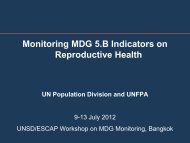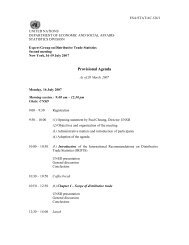demographic yearbook annuaire demographique 1951
demographic yearbook annuaire demographique 1951
demographic yearbook annuaire demographique 1951
You also want an ePaper? Increase the reach of your titles
YUMPU automatically turns print PDFs into web optimized ePapers that Google loves.
correspondence is not perfect, of course, because the agedistributions<br />
are not completely regular in shape.<br />
The median age is that age which divides the population<br />
in two equal parts, one half being older and one half being<br />
younger than the median. The distribution of different<br />
populations with the same median can differ greatly from<br />
one another both above and below the median. However,<br />
it is a convenient summarizing measure of the age composition<br />
of a population and in general reflects the kinds of<br />
differences with which we are here concerned. The percentage<br />
70 years old and over shows an equally close correspondence<br />
to the age-adjusted rates of Area A and underlines<br />
the importance of the relative numbers of older persons<br />
in determining the level of the crude death rate. Therefore,<br />
in comparing the crude death rate of a young population<br />
with the crude death rate of an older population it should<br />
be kept in mind that, from the point of view of age-specific<br />
mortality, the rate of the younger population is likely to be<br />
understated relative to the rate of the older population.<br />
The factor of age is also important in interpreting trends<br />
in mortality as measured by changes over time in the crude<br />
death rate. If a decline in the rate is accompanied by an<br />
"aging" of the population (i.e., a rise in the median age as<br />
increasing proportions of the population survive to the older<br />
ages), the actual decrease in age-specific mortality is understated<br />
by the change in the crude rate. By the same token,<br />
if the crude rate remains stable or rises while the population<br />
ages this does not necessarily mean that age-specific mortality<br />
has stabilized or increased. In fact, it can happen that<br />
age-specific mortality has actually decreased. For example,<br />
the crude rate of Australia rose from 9.4 in 1936 to 9.7 in<br />
1947. A comparison of age-specific death rates for these<br />
two years shows that there was a decrease at every age<br />
(see table 17). Thus the aging of the population in the space<br />
of 11 years was sufficient to obscure the decline in mortality<br />
as measured by the crude rate.<br />
If, on the other hand, a decline in the crude death rate is<br />
accompanied by an increase in the proportion of the population<br />
at younger ages (or a fall in the median age), the<br />
TABLE<br />
Age-adjusted death rates of Area A and Area B based on the<br />
age distributions of specified populations<br />
B<br />
Median Percentage<br />
Age-adjusted death rates age 70years<br />
oj base old and<br />
Base population Area A Area B population over<br />
(1) (2) (3) (4)<br />
England & Wales (1948) . 13.2 28.7 34.8 6.6<br />
Sweden (1948) ......... 12.8 28.5 33.9 6.2<br />
Ireland (1946) ......... 12.5 28.5 29.1 6.8<br />
New Zealand (1945) ..... 11.4 27.5 31.3 5.0<br />
England & Wales (1931). 10.1 24.0 30.3 4.2<br />
United States (1940) .... 9.7 23.6 29.0 4.0<br />
Netherlands (1930) ...... 9.4 24.6 25.6 3.6<br />
Bulgaria (1934) ......... 9.0 23.8 23.8 3.2<br />
Japan (1947) ........... 8.2 24.8 22.3 2.6<br />
Jamaica (1943) ......... 8.1 23.7 22.2 2.8<br />
British Guiana (1946) .... 8.0 25.0 21.4 2.1<br />
Israel (1948):<br />
Jewish population..... 7.8 23.4 27.1 2.3<br />
Honduras (1945) ....... 7.6 25.6 18.7 1.7<br />
Venezuela (1941) ....... 6.9 23.8 19.3 1.6<br />
Thailand (1947) ........ 6.7 23.8 18.4 1.4<br />
Algeria (1948):<br />
Moslem population.... 6.5 22.6 18.4 1.4<br />
actual decline in mortality may be overstated by the change<br />
in the crude rate. It often happens, in areas of relatively<br />
high mortality, that a more rapid reduction is made in the<br />
death rate of infants and young children than in death rates<br />
at other ages. This can result in so increasing the number<br />
of survivors at the young ages that the median age of the<br />
population is lowered. In areas of this type, a decline in the<br />
crude rate may be reflecting the conquest of infant mortality<br />
while death rates at other ages remain relatively unchanged.<br />
In the long run, however, the effect of reduction in mortality<br />
is to raise the average age of the population. Only if the<br />
number of births increases sufficiently to offset the aging<br />
effects of mortality, will the average age of the population<br />
remain stable or decrease.<br />
Mention has been made of the effect on crude rates of<br />
varying differences between age-specific rates for different<br />
areas and times. The effect of this factor can be judged by<br />
comparing the rank and level of age-adjusted rates for<br />
Area B with those of the age-adjusted rates for Area A<br />
which have just been described. Such rates are shown in<br />
column 2 of table B.<br />
It will be seen at once that the relative difference between<br />
Area A and Area B is greater for each pair of age-adjusted<br />
rates than for their own crude rates (12.0 and 23.1 respectively).<br />
Thus, if Area A and Area B had the same age<br />
composition, the contrast between them would be more<br />
striking.<br />
Two other changes in relationship are apparent. In the<br />
first place, the relative range is considerably less among the<br />
Area B rates than among the Area A rates, the highest rate<br />
being only 27 per cent higher than the lowest. It becomes<br />
clear, then, that with a schedule of age-specific rates like<br />
those of Area B, the effect of differences in age-composition,<br />
or of aging of the population, is less important than is the<br />
case with age-specific rates like those of Area A. The chief<br />
reason for this is the higher death rates of infants and young<br />
children, which mean that aging of the population has a<br />
smaller effect on the all-ages rate than is the case with the A<br />
rates. The latter rates, being relatively low at all except the<br />
advanced ages, are more sensitive to aging.<br />
The second effect of the higher age-specific death rates is<br />
to alter the rank of the age-adjusted rates. The population<br />
of England and Wales 1948 still yields the highest rate and<br />
the population of Algeria the lowest rate, but the order of<br />
the intervening rates is somewhat changed. This alteration<br />
is attributable also to the increased influence of mortality<br />
at the very young ages upon the total rate. For example,<br />
the rate based on the population of the United States 1940<br />
dropped from fifth place with the age-specific rates ofArea A<br />
to fourteenth place with the age-specific rates of Area B.<br />
In the United States in 1940 the percentage of the population<br />
that was under 5 years of age was very low as a result<br />
of the low birth rates during the preceding decade. Consequently<br />
the higher death rates for this age-group did not<br />
affect the total rate so strongly as they did in the case of<br />
Honduras which had a high percentage of young children<br />
in 1945 and which moved up from thirteenth place with the<br />
rates of Area A to fifth place with the rates of Area B.<br />
However, the general order remains, the older populations<br />
tending to yield higher rates and the younger, lower rates.<br />
In other words, the two sets of rates are positively correlated.<br />
Special attention should be given to the effect on crude<br />
rates of populations such as those of Ireland 1946 and<br />
Israel 1948. The former is a population that has experienced<br />
fairly heavy out-migration with the result that the propor-<br />
10













